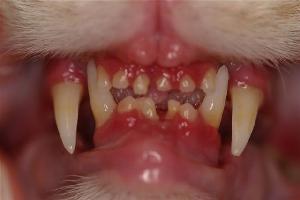Feline Gum Disease
Dental disease is the most common disease in cats, affecting nearly every cat 5 years and older, according to Dr. Arnold Plotnick of Manhattan Cat Specialists. Gum disease is one of the leading diseases of the mouth in felines, often leading to other medical problems such as tooth loss, sinus infections and even heart failure. With awareness of the problem and some precautions, you can help your cats avoid this very preventable ailment.
Identification
Feline periodontal disease, also known as feline gum disease, is inflammation of the tissues surrounding and supporting the teeth. Feline periodontal disease weakens cats' teeth and gums, often leading to other more serious medical conditions.
Symptoms
Look for the following signs and symptoms if feline periodontal disease is suspected. Look at the appearance of the teeth and gums. Yellow or brown spots on the teeth, receding gum lines, or reddened edges of gum lines are all symptoms of periodontal disease. Bad breath is another telling sign. Other symptoms include blood-tinged drool, mouth pain, and difficulty chewing food.
Causes
Over-crowded teeth and genetics are two contributors to feline periodontal disease, but there are many others. The older a cat grows, the more likely it is to suffer from gum disease. Certain breeds such as Persians, Himalayans and Siamese suffer from periodontal disease more often than other breeds. If the cat's diet consists of mainly soft food, it will be more at risk for periodontal disease than a cat that eats hard food. Also, cats that do not receive regular home or veterinary dental care will be more at risk of developing periodontal disease.
Treatment
A veterinarian will examine a cat's mouth to diagnose feline periodontal disease, looking for irritated gums or decayed teeth. The veterinarian may recommend oral radiographies (X-rays) to determine the severity of the disease. Most often, the cat will be anesthetized and the tooth debris, along with any infection, will be physically removed. In severe cases, badly decayed teeth will often be removed. Antibiotics may be required to help treat infection, and pain medication may be required to help treat pain from any dental procedures.
Prevention/Solution
Regular dental care and maintenance are the only ways to prevent feline periodontal disease. Ask your veterinarian to recommend a specially formulated toothpaste to use with a feline toothbrush , and brush your cat's teeth at home several times per week. Use brushing your cat's teeth as an opportunity to get a good look at his mouth, checking for any signs of problems. Also, take your cat to the veterinarian for a yearly dental exam to look for and prevent any upcoming dental problems.
Articles by Dr. Plotnick - Dentistry and Oral Disorders
- Get link
- X
- Other Apps

Comments
Post a Comment